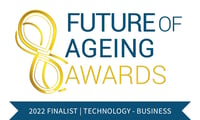Published in Aged Care Insite by Tammy Sherwood.
Although the exact number of people living with dementia in Australia is currently not known, it is estimated there could be as many as 472,000 Australians living with the condition. Without a medical breakthrough, this number is expected to increase to 590,000 by 2028 and 1,076,000 by 2058.
With this figure growing year-on-year, residential aged care settings must continuously adapt to ensure they can carry out the proper care required for people with the condition.
Thankfully, advancements in technology have so much to offer people living with dementia and their carers, from access to information and advice to software that helps detect discomfort in non-verbal communication. When used sensitively and thoughtfully, this technology enhances rather than replaces human relationships and interactions and enables staff to provide more responsive and personalised dementia care. In turn, this improves residents’ quality of life.
For example, agile and innovative digital clinical documentation systems designed specifically for the care sector have become more widely available in recent times and are growing in popularity as care homes transition from the paper-based models favoured previously. These are incredibly effective at fostering safe, comfortable environments for people living with any form of dementia.
Incorporating profile-building software, digital clinical documentation systems improve the quality of information on a person's life, which is vital for providing care that focuses on each person as an individual. By empowering staff with details on a resident’s life story, likes and dislikes, they can draw upon it in crucial situations to help someone with dementia.
For example, if a resident with dementia is showing signs of distress, there are digital tools that can provide information such as that person’s favourite poem. This can be used to help calm them and to aid with reminiscing; a core focus for someone with dementia.
With the use of technology, it is also increasingly possible for carers to interact with residents with dementia without needing to extract information from them. This can be an uncomfortable experience and even more daunting for the resident if they don't recognise the face in front of them. A simple click and scroll on a handheld device can show carers what a dementia resident’s routine is, what they like to talk about and what makes them feel better if they are anxious or upset. Interactions naturally become easier and more interactive for both parties, and friendships can be formed and fostered through trust.
Software that enables carers to identify, monitor and reduce pain in residents is helping aged care homes deliver better dementia care, too. Able to detect and measure involuntary micro-facial expressions typically associated with pain, technology can help carers identify the presence and quantify the severity of pain in those living with dementia.
Given that people with dementia often struggle to verbalise their thoughts and feelings, the value of these technologies, which make it possible for carers to intervene and reduce pain in its early stages, cannot be underestimated.
Having a wealth of information at your fingertips that can improve someone’s quality of life is a remarkable thing, and not all too long ago was unachievable. Now, we live in a world where technology is integrated into everything around us and can be used to enhance the mental and physical wellbeing of others.
There is a reason so many care providers are digitalising their care environments – they understand that care technology is built to help and support the caregiver and receiver at a rate never achieved before. They are also seeing that digital clinical documentation systems, which focus on each resident and their individual goals or wishes, encourages a more person-centred approach to care delivery, rather than focussing on the funding aspect, which is not person-centred at all.
As cases of dementia continue to rise, so does our understanding and capability to cope with the growing numbers through the utilisation of user-friendly, person-centred technology. Profile-building software allows carers to delve into the lives of the person sitting in front of them, and that is special.











